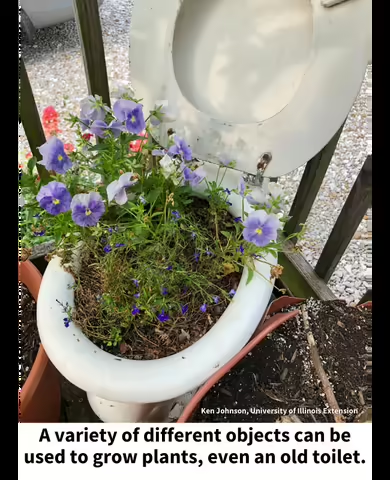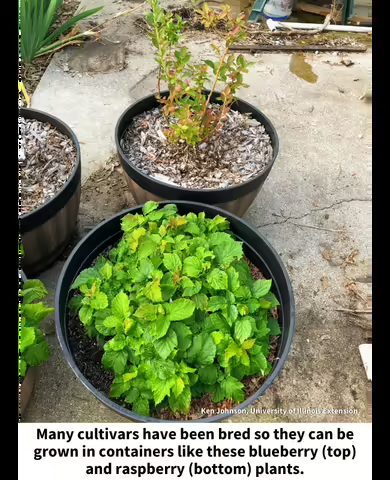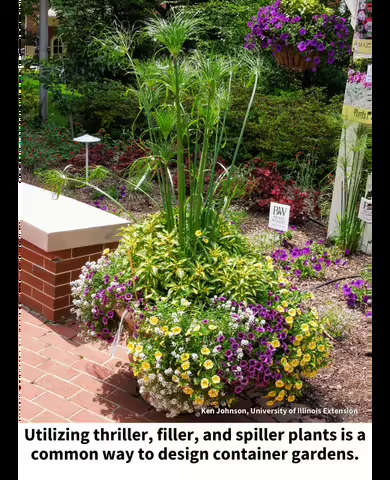
Do you have limited space to grow plants outdoors? Or maybe you have an area that could use some color but don’t have anywhere to put plants in the ground. Container gardens may be the solution to your problem.
Almost anything that you can grow in the garden can also be grown in a container. You just need to provide a few basic needs to your plants – a container, growing media, water, nutrients, and light. When growing plants in a container, here are some things to consider:
Advantages and disadvantages of growing in containers
In addition to being able to grow in areas where you may not be able to otherwise, such as patios, balconies, decks, and porches, container gardens can be mobile. This can allow you to move containers around to take advantage of sunlight. It can also be helpful if you grow plants sensitive to cold weather. When it starts getting cold, they can be moved indoors to extend the growing season.
When growing in containers, you also have control over the growing media that is being used. Therefore, it can be adjusted to the type of plant(s) you are growing.
Container gardening isn’t without its disadvantages, though. It tends to be more expensive than growing in-ground because containers and growing media need to be purchased. However, there are ways to reduce these costs by re-purposing items as containers.
Container-grown plants will need to be watered more frequently than those grown in-ground. It can also be difficult to grow some types of plants and crops in containers, although not impossible.
What type of container?
Anything that can hold soil and has drainage can be used to grow plants. This can be a pot from the store, a bucket, a milk carton, or even a shoe or an old toilet. Although, if you’re going to be growing something you plan on eating, it’s best to stick to a more traditional pot. If you are re-purposing an item, clean it with soapy water and disinfect it with a 10% bleach solution.
All containers have their advantages and disadvantages. Containers made of porous materials like terra cotta and fabric will dry out much faster than non-porous materials like plastic or glazed ceramic. Additionally, water within the pores of terra cotta and clay pots will expand when frozen, leading to cracked pots. These pots will need to be dried, protected, or brought indoors during the winter to prevent this.
Dark-colored containers and those made of metal will absorb more heat than other types of pots. This will heat the soil and can damage plants, and cause the growing media to dry out more quickly.
Plastic, resin, and fiberglass containers are lighter than many other types of pots. While this is an advantage when it comes to moving the containers, if you are growing larger or top-heavy plants such as trees, these containers are more prone to tipping over.
The shape of the pot can also affect how stable it is. Square pots are the most stable. In contrast, traditional pots (tapered from the top down) are the least and pots with straight sides in between.
Regardless of what container you use, make sure that the container has drainage holes, and if it doesn’t, make some. Also, make sure your container will be big enough to support your plant once it is fully grown.
Growing media
When choosing a growing media for your container, you need to choose something that is well aerated, drains well, and can hold enough water for the plant to grow. Soilless media are generally the best option for container gardening. They are typically made up of peat, vermiculite, bark, coconut coir, and/or perlite. These can be purchased commercially as all-purpose potting mixes, or you can make your own.
Avoid using garden soils; they can contain weed seeds and pathogens and often don’t drain well enough to be used in containers.
Choosing plants
While you can grow almost any plant you want in a container, some will be easier than others. Large vining plants like pumpkins and squash will likely get too large for containers. Fortunately, there are bush cultivars of some of these crops that can be grown in larger containers. The same can be said for tomatoes. Indeterminate tomatoes often grow too large for containers, but determinate tomatoes stay smaller and are a better option for growing in containers.
When selecting a container, keep the size of your plants in mind. Smaller plants like lettuce, begonias, coleus, and pansies can be grown in smaller containers (4-6”). While larger plants such as peppers, tomatoes, geraniums, and some zinnias will need larger containers (12”+, or 2 to 5 gallons).
Trees, shrubs, and other perennials can also be grown in containers. Again, as with annuals, smaller species and cultivars will be easier to grow in containers than larger ones. If you decide to grow perennial plants in containers, make sure to take steps to overwinter them in the fall.
Planting and care
After selecting your plants, container, and growing media, it’s time to plant! Before planting, make sure to wet down your growing media thoroughly. Then fill your container. Leave about one inch of space between the rim of your container and the soil. This will help prevent water from overflowing your container.
If growing your plants from seed, plant at the depth indicated on the seed package. It is usually a good idea to overseed and then thin the seedlings to the spacing indicated on the package since not all seeds may germinate.
If growing from transplants, use plants that look healthy. While containers may seem sparse when first planted, make sure you follow proper spacing (it’s okay to plant a little closer, but not too much). Plants that are packed in close to one another can shade each other out. It can also increase the likelihood of disease development due to reduced air circulation.
If you are planting different species of plants together, make sure they have similar growth requirements (sun exposure, moisture needs, etc.). Also, keep the plants’ size, shape, color, and texture in mind as you are designing your containers.
An easy way to design a container is to use plants that are thrillers, fillers, and spillers.
- Thrillers are the focal point and are usually bright, tall plants and flowers like canna lilies or ornamental grasses.
- Fillers are often round, mounding, lower growing plants that make containers look full like begonia, coleus, and geraniums.
- Spillers are plants that hang over the side of the container, like calibrachoa, nasturtium, and sweet potato vines.
Finally, make sure to thoroughly water your container after they have been planted.
Watering
Providing adequate water to your plants is vital for success. Growing media in containers will dry out much faster than soil in the ground. Plants will vary in their water requirements, but a general rule of thumb is that plants should be watered when the top inch or so of your growing media feels dry.
Water plants thoroughly until water starts to trickle out of the drainage holes. If you are using a plant saucer under your pot, make sure to dump any water that collects. This will help prevent soils from staying too moist and eliminate potential breeding sites for mosquitoes.
In warm, dry weather, you may need to water your containers daily, if not more often. If you use unglazed ceramic pots, remember they tend to dry out faster than glazed or plastic pots.
Fertilizing
Soil-less media are usually low in nutrients. Because of this, plants growing in them may need to be fertilized at some point. You can use either slow-release or liquid fertilizers.
Slow-release fertilizers are fertilizers that are covered in a semi-permeable coating. When this coating gets wet, it will release small amounts of nutrients. Therefore, proper watering is important for these fertilizers to work properly. These products will often supply nutrients for 3-4 months. Slow-release fertilizers are often mixed into bagged potting media.
Liquid fertilizers are mixed with water and applied to containers during watering, and the nutrients are immediately available to plants. They are often applied every two weeks or can be applied at every watering if a diluted solution is used.
Regardless of what fertilizer you choose to use, follow the directions on the label when applying fertilizers to avoid damage to your plants.
Good Growing Tip of the Week: You can skip the pot altogether and grow your plants (annuals) directly in a bag of potting ‘soil’. Lay your bag of potting mix on the ground, cut a hole in the top for your plants, and plant them directly in the media (make sure you put some drainage holes on the bottom).
Bonus Tip of the Week: Soilless potting mixes tend to shrink if they dry out too much. This can lead to gaps between the mix and the container walls, making it difficult to rewet the growing media. If this happens, the container can be placed in a bucket or sink full of water until the top of the growing media is moist.
Signup for our emails! Want to get notified when new Good Growing posts are available? SIGN ME UP
MEET THE AUTHOR
Ken Johnson is a Horticulture Educator with University of Illinois Extension, serving Calhoun, Cass, Greene, Morgan, and Scott counties since 2013. Ken provides horticulture programming with an emphasis on fruit and vegetable production, pest management, and beneficial insects. Through his programming, he aims to increase backyard food production and foster a greater appreciation of insects.


